Management Accounting Report: KEF Manufacturing Case Study
VerifiedAdded on 2021/02/19
|20
|4288
|19
Report
AI Summary
This report delves into the realm of management accounting, exploring its core concepts, essential requirements, and various reporting methods. It utilizes Alpha FMC, a London-based consultancy, and its client, Kent Engineering and Foundry (KEF), a loudspeaker manufacturer, as a case study to illustrate the practical application of management accounting systems. The report examines different management accounting systems, including costing, price optimization, inventory management, and job costing systems, assessing their benefits within the context of KEF Manufacturing. Furthermore, it analyzes various management accounting reporting techniques, such as budget reports, performance reports, and job costing reports, and evaluates the integration of management accounting systems and reporting within organizational processes. The report also covers the computation of costs using marginal and absorption costing techniques, the advantages and disadvantages of budgetary control, and compares how organizations adopt management accounting systems in response to financial problems. Finally, it analyzes how management accounting systems aid in resolving financial problems sustainably and evaluates how planning tools help in achieving sustainable success.
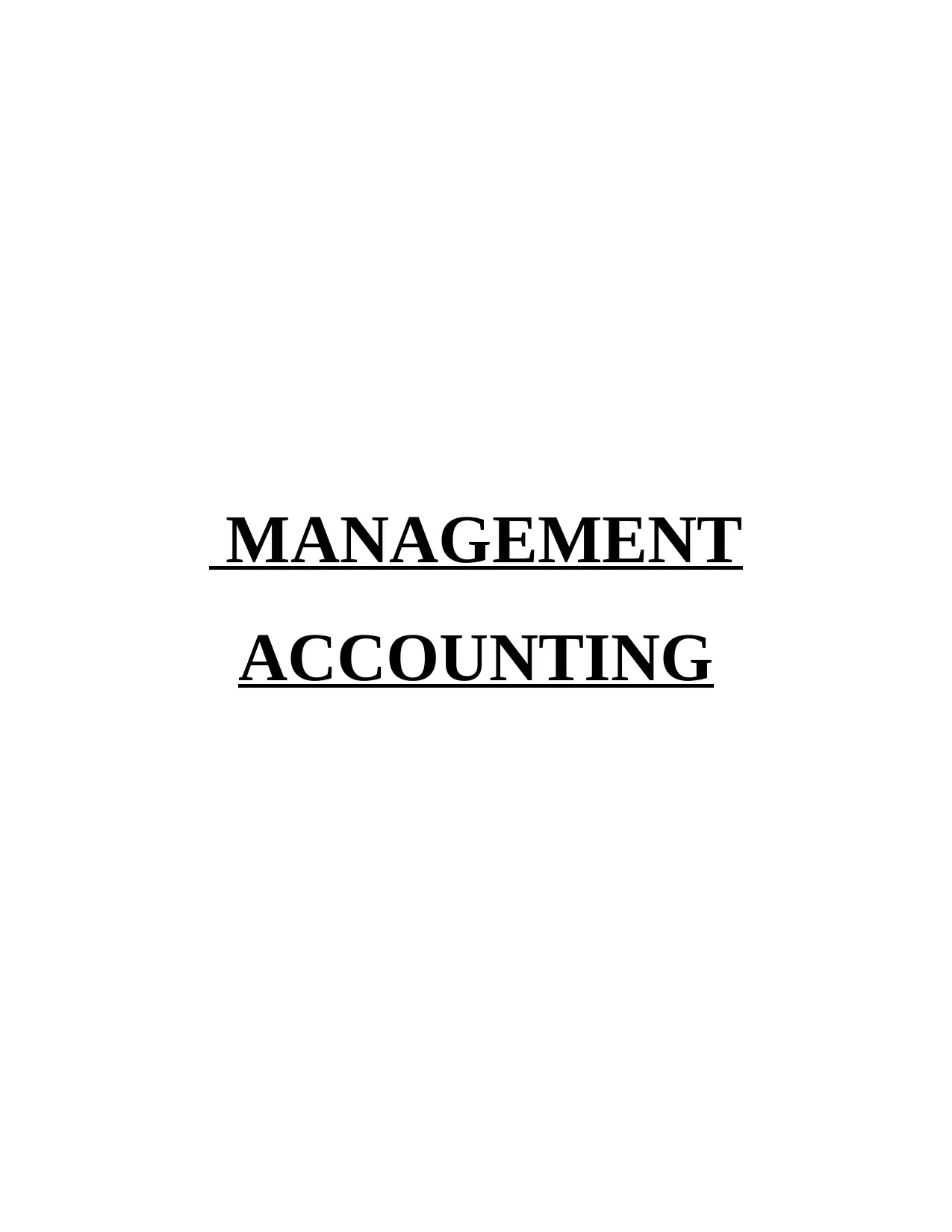
MANAGEMENT
ACCOUNTING
ACCOUNTING
Paraphrase This Document
Need a fresh take? Get an instant paraphrase of this document with our AI Paraphraser

Table of Contents
INTRODUCTION...........................................................................................................................4
TASK 1............................................................................................................................................4
P1. Concept of Management Accounting and its essential requirements..............................4
P2. Various methods used for management accounting reporting.........................................6
M1. Assessing benefits of MAS in the context of KEF Manufacturing................................8
D1. Critical evaluation of integrating MAS and MAR within organizational processes.......8
TASK 2............................................................................................................................................8
P3. Computation of costs using Marginal and Absorption Costing Techniques....................8
.............................................................................................................................................12
M2. Application of Management Accounting techniques....................................................14
D2. Production of Financial Reports that enable data interpretation of various business
activities................................................................................................................................14
TASK 3..........................................................................................................................................14
P4. Advantages and disadvantages of different kind of planning tools of budgetary control14
M3. Types of planning tools and their application for preparing and forecasting of budgets.16
TASK 4..........................................................................................................................................17
P5. Comparing the ways organisations adopt MAS in response of Financial Problems.....17
Comparing implementation of MAS among different organisations...................................18
M4. Analysis of how management accounting system help in resolution of financial problems
sustainably............................................................................................................................19
D3. Evaluating how Planning tools help in resolution of financial problems to achieve
sustainable success...............................................................................................................19
CONCLUSION..............................................................................................................................20
REFERENCES..............................................................................................................................21
INTRODUCTION...........................................................................................................................4
TASK 1............................................................................................................................................4
P1. Concept of Management Accounting and its essential requirements..............................4
P2. Various methods used for management accounting reporting.........................................6
M1. Assessing benefits of MAS in the context of KEF Manufacturing................................8
D1. Critical evaluation of integrating MAS and MAR within organizational processes.......8
TASK 2............................................................................................................................................8
P3. Computation of costs using Marginal and Absorption Costing Techniques....................8
.............................................................................................................................................12
M2. Application of Management Accounting techniques....................................................14
D2. Production of Financial Reports that enable data interpretation of various business
activities................................................................................................................................14
TASK 3..........................................................................................................................................14
P4. Advantages and disadvantages of different kind of planning tools of budgetary control14
M3. Types of planning tools and their application for preparing and forecasting of budgets.16
TASK 4..........................................................................................................................................17
P5. Comparing the ways organisations adopt MAS in response of Financial Problems.....17
Comparing implementation of MAS among different organisations...................................18
M4. Analysis of how management accounting system help in resolution of financial problems
sustainably............................................................................................................................19
D3. Evaluating how Planning tools help in resolution of financial problems to achieve
sustainable success...............................................................................................................19
CONCLUSION..............................................................................................................................20
REFERENCES..............................................................................................................................21
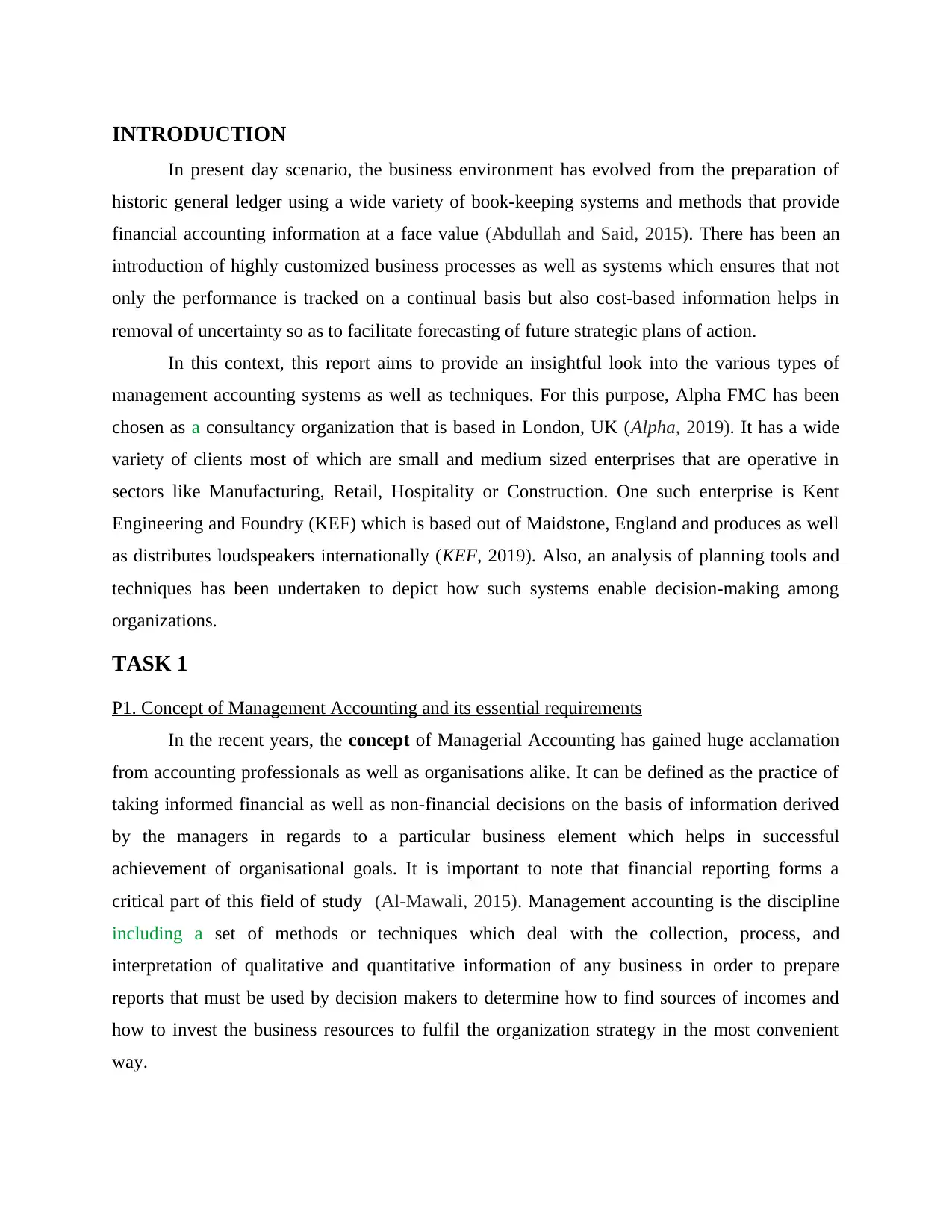
INTRODUCTION
In present day scenario, the business environment has evolved from the preparation of
historic general ledger using a wide variety of book-keeping systems and methods that provide
financial accounting information at a face value (Abdullah and Said, 2015). There has been an
introduction of highly customized business processes as well as systems which ensures that not
only the performance is tracked on a continual basis but also cost-based information helps in
removal of uncertainty so as to facilitate forecasting of future strategic plans of action.
In this context, this report aims to provide an insightful look into the various types of
management accounting systems as well as techniques. For this purpose, Alpha FMC has been
chosen as a consultancy organization that is based in London, UK (Alpha, 2019). It has a wide
variety of clients most of which are small and medium sized enterprises that are operative in
sectors like Manufacturing, Retail, Hospitality or Construction. One such enterprise is Kent
Engineering and Foundry (KEF) which is based out of Maidstone, England and produces as well
as distributes loudspeakers internationally (KEF, 2019). Also, an analysis of planning tools and
techniques has been undertaken to depict how such systems enable decision-making among
organizations.
TASK 1
P1. Concept of Management Accounting and its essential requirements
In the recent years, the concept of Managerial Accounting has gained huge acclamation
from accounting professionals as well as organisations alike. It can be defined as the practice of
taking informed financial as well as non-financial decisions on the basis of information derived
by the managers in regards to a particular business element which helps in successful
achievement of organisational goals. It is important to note that financial reporting forms a
critical part of this field of study (Al-Mawali, 2015). Management accounting is the discipline
including a set of methods or techniques which deal with the collection, process, and
interpretation of qualitative and quantitative information of any business in order to prepare
reports that must be used by decision makers to determine how to find sources of incomes and
how to invest the business resources to fulfil the organization strategy in the most convenient
way.
In present day scenario, the business environment has evolved from the preparation of
historic general ledger using a wide variety of book-keeping systems and methods that provide
financial accounting information at a face value (Abdullah and Said, 2015). There has been an
introduction of highly customized business processes as well as systems which ensures that not
only the performance is tracked on a continual basis but also cost-based information helps in
removal of uncertainty so as to facilitate forecasting of future strategic plans of action.
In this context, this report aims to provide an insightful look into the various types of
management accounting systems as well as techniques. For this purpose, Alpha FMC has been
chosen as a consultancy organization that is based in London, UK (Alpha, 2019). It has a wide
variety of clients most of which are small and medium sized enterprises that are operative in
sectors like Manufacturing, Retail, Hospitality or Construction. One such enterprise is Kent
Engineering and Foundry (KEF) which is based out of Maidstone, England and produces as well
as distributes loudspeakers internationally (KEF, 2019). Also, an analysis of planning tools and
techniques has been undertaken to depict how such systems enable decision-making among
organizations.
TASK 1
P1. Concept of Management Accounting and its essential requirements
In the recent years, the concept of Managerial Accounting has gained huge acclamation
from accounting professionals as well as organisations alike. It can be defined as the practice of
taking informed financial as well as non-financial decisions on the basis of information derived
by the managers in regards to a particular business element which helps in successful
achievement of organisational goals. It is important to note that financial reporting forms a
critical part of this field of study (Al-Mawali, 2015). Management accounting is the discipline
including a set of methods or techniques which deal with the collection, process, and
interpretation of qualitative and quantitative information of any business in order to prepare
reports that must be used by decision makers to determine how to find sources of incomes and
how to invest the business resources to fulfil the organization strategy in the most convenient
way.
⊘ This is a preview!⊘
Do you want full access?
Subscribe today to unlock all pages.

Trusted by 1+ million students worldwide
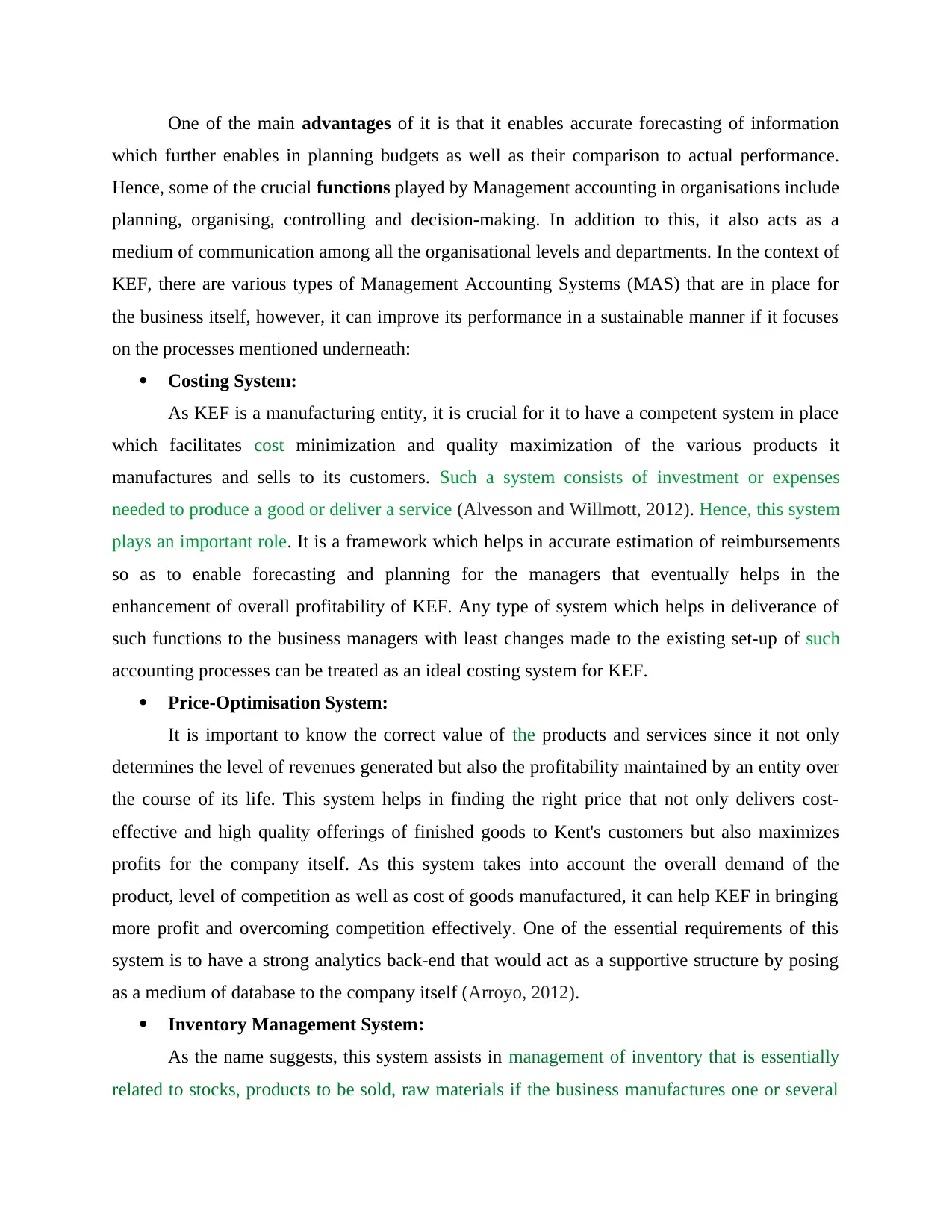
One of the main advantages of it is that it enables accurate forecasting of information
which further enables in planning budgets as well as their comparison to actual performance.
Hence, some of the crucial functions played by Management accounting in organisations include
planning, organising, controlling and decision-making. In addition to this, it also acts as a
medium of communication among all the organisational levels and departments. In the context of
KEF, there are various types of Management Accounting Systems (MAS) that are in place for
the business itself, however, it can improve its performance in a sustainable manner if it focuses
on the processes mentioned underneath:
Costing System:
As KEF is a manufacturing entity, it is crucial for it to have a competent system in place
which facilitates cost minimization and quality maximization of the various products it
manufactures and sells to its customers. Such a system consists of investment or expenses
needed to produce a good or deliver a service (Alvesson and Willmott, 2012). Hence, this system
plays an important role. It is a framework which helps in accurate estimation of reimbursements
so as to enable forecasting and planning for the managers that eventually helps in the
enhancement of overall profitability of KEF. Any type of system which helps in deliverance of
such functions to the business managers with least changes made to the existing set-up of such
accounting processes can be treated as an ideal costing system for KEF.
Price-Optimisation System:
It is important to know the correct value of the products and services since it not only
determines the level of revenues generated but also the profitability maintained by an entity over
the course of its life. This system helps in finding the right price that not only delivers cost-
effective and high quality offerings of finished goods to Kent's customers but also maximizes
profits for the company itself. As this system takes into account the overall demand of the
product, level of competition as well as cost of goods manufactured, it can help KEF in bringing
more profit and overcoming competition effectively. One of the essential requirements of this
system is to have a strong analytics back-end that would act as a supportive structure by posing
as a medium of database to the company itself (Arroyo, 2012).
Inventory Management System:
As the name suggests, this system assists in management of inventory that is essentially
related to stocks, products to be sold, raw materials if the business manufactures one or several
which further enables in planning budgets as well as their comparison to actual performance.
Hence, some of the crucial functions played by Management accounting in organisations include
planning, organising, controlling and decision-making. In addition to this, it also acts as a
medium of communication among all the organisational levels and departments. In the context of
KEF, there are various types of Management Accounting Systems (MAS) that are in place for
the business itself, however, it can improve its performance in a sustainable manner if it focuses
on the processes mentioned underneath:
Costing System:
As KEF is a manufacturing entity, it is crucial for it to have a competent system in place
which facilitates cost minimization and quality maximization of the various products it
manufactures and sells to its customers. Such a system consists of investment or expenses
needed to produce a good or deliver a service (Alvesson and Willmott, 2012). Hence, this system
plays an important role. It is a framework which helps in accurate estimation of reimbursements
so as to enable forecasting and planning for the managers that eventually helps in the
enhancement of overall profitability of KEF. Any type of system which helps in deliverance of
such functions to the business managers with least changes made to the existing set-up of such
accounting processes can be treated as an ideal costing system for KEF.
Price-Optimisation System:
It is important to know the correct value of the products and services since it not only
determines the level of revenues generated but also the profitability maintained by an entity over
the course of its life. This system helps in finding the right price that not only delivers cost-
effective and high quality offerings of finished goods to Kent's customers but also maximizes
profits for the company itself. As this system takes into account the overall demand of the
product, level of competition as well as cost of goods manufactured, it can help KEF in bringing
more profit and overcoming competition effectively. One of the essential requirements of this
system is to have a strong analytics back-end that would act as a supportive structure by posing
as a medium of database to the company itself (Arroyo, 2012).
Inventory Management System:
As the name suggests, this system assists in management of inventory that is essentially
related to stocks, products to be sold, raw materials if the business manufactures one or several
Paraphrase This Document
Need a fresh take? Get an instant paraphrase of this document with our AI Paraphraser

products, etc. which further helps in preparation of financial reports of the company. In order to
ascertain the correct system for the Kent Engineering, it is important to know how well the
suppliers management is executed through it along with synchronization of marketplaces. Hence,
KEF must internally understand its existing inventory management policy so as to improve them
by bring in more customization to such policies and procedures (Bebbington, Unerman and
O’DWYER, 2014).
Job Costing System:
This type of accounting system is kind of a specific order costing method under which
costs are first accumulated then associated to individual cost-units called 'Jobs'. The main
purpose of this system is to ascertain jobs related to each unit and derive the profit earned from
them individually. It is suitable for those businesses which manufacture customer specific goods
made and delivered. The essential pre-requisites for this system is that an effective production
control system is existent in the organisation along with properly classified, apportioned and
absorption methodologies implemented for overheads. As KEF fulfils these conditions,
implementation of this system can help in improving Kent's performance and profitability.
P2. Various methods used for management accounting reporting
Some of the crucial functions performed by Management Accounting is to act as a means
of communication to both internal as well as external stakeholders of the company (Busco,
Caglio and Scapens, 2015). This is usually done by consolidation of financial and non-financial
information in a manner which gives an overview of the business activities, performance,
profitability and projects that have been undertaken by such enterprise in a given fiscal year. For
this purpose, important financial reports are formulated for a specific time-period. Some of the
important methodologies that are adopted for Management Accounting Reporting (MAR) have
been enlisted below:
Budget Reports:
Preparation of such reports helps in critical assessment of company's performance in
terms of departments, costs as well as the business as a whole. A budget estimate is usually
inclusive of previous experiences along with future contingencies that may arise in relation to the
earnings and expenditures for a given time-period (Franco-Santos, Lucianetti and Bourne, 2012).
Hence, using this report is crucial as it enables proper planning of scarce resources available with
ascertain the correct system for the Kent Engineering, it is important to know how well the
suppliers management is executed through it along with synchronization of marketplaces. Hence,
KEF must internally understand its existing inventory management policy so as to improve them
by bring in more customization to such policies and procedures (Bebbington, Unerman and
O’DWYER, 2014).
Job Costing System:
This type of accounting system is kind of a specific order costing method under which
costs are first accumulated then associated to individual cost-units called 'Jobs'. The main
purpose of this system is to ascertain jobs related to each unit and derive the profit earned from
them individually. It is suitable for those businesses which manufacture customer specific goods
made and delivered. The essential pre-requisites for this system is that an effective production
control system is existent in the organisation along with properly classified, apportioned and
absorption methodologies implemented for overheads. As KEF fulfils these conditions,
implementation of this system can help in improving Kent's performance and profitability.
P2. Various methods used for management accounting reporting
Some of the crucial functions performed by Management Accounting is to act as a means
of communication to both internal as well as external stakeholders of the company (Busco,
Caglio and Scapens, 2015). This is usually done by consolidation of financial and non-financial
information in a manner which gives an overview of the business activities, performance,
profitability and projects that have been undertaken by such enterprise in a given fiscal year. For
this purpose, important financial reports are formulated for a specific time-period. Some of the
important methodologies that are adopted for Management Accounting Reporting (MAR) have
been enlisted below:
Budget Reports:
Preparation of such reports helps in critical assessment of company's performance in
terms of departments, costs as well as the business as a whole. A budget estimate is usually
inclusive of previous experiences along with future contingencies that may arise in relation to the
earnings and expenditures for a given time-period (Franco-Santos, Lucianetti and Bourne, 2012).
Hence, using this report is crucial as it enables proper planning of scarce resources available with
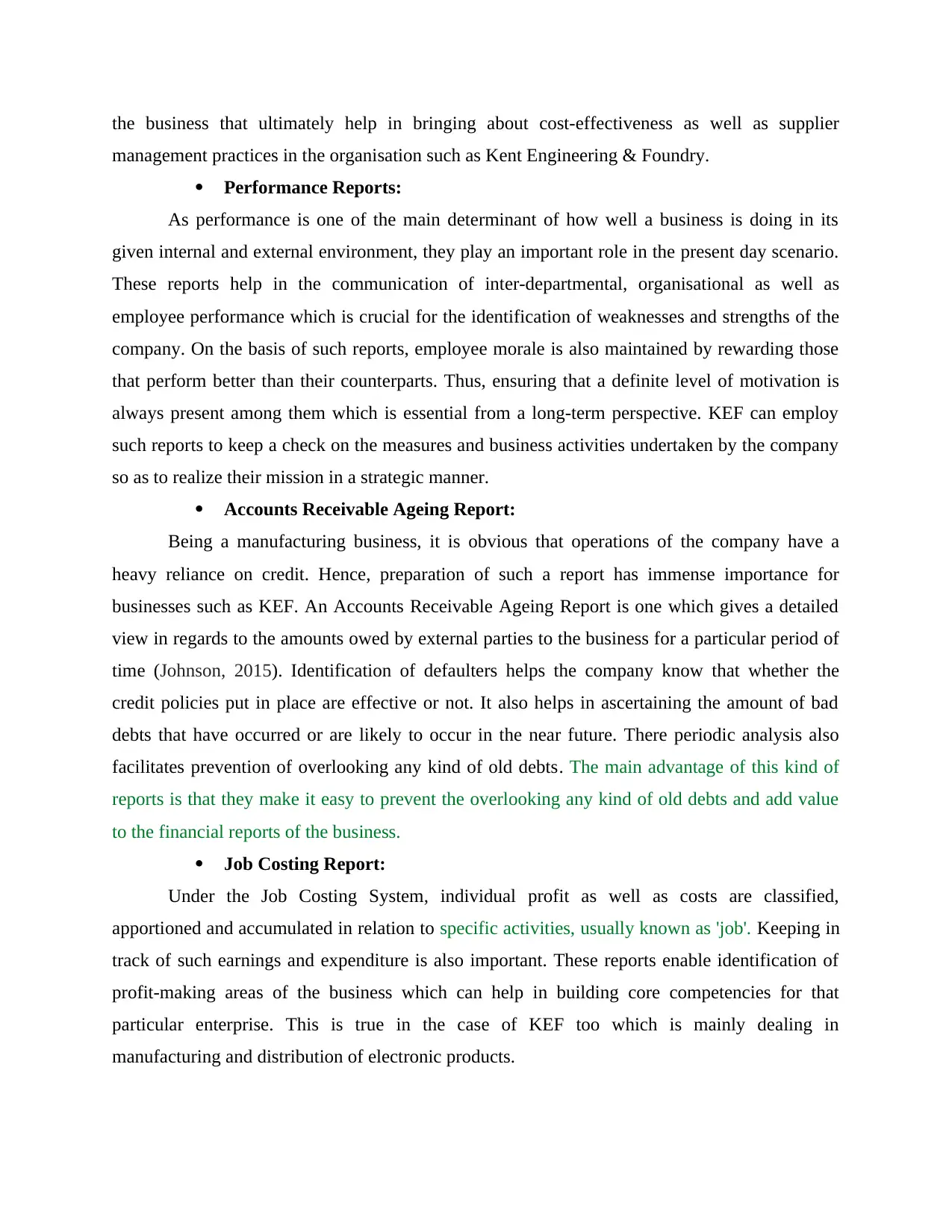
the business that ultimately help in bringing about cost-effectiveness as well as supplier
management practices in the organisation such as Kent Engineering & Foundry.
Performance Reports:
As performance is one of the main determinant of how well a business is doing in its
given internal and external environment, they play an important role in the present day scenario.
These reports help in the communication of inter-departmental, organisational as well as
employee performance which is crucial for the identification of weaknesses and strengths of the
company. On the basis of such reports, employee morale is also maintained by rewarding those
that perform better than their counterparts. Thus, ensuring that a definite level of motivation is
always present among them which is essential from a long-term perspective. KEF can employ
such reports to keep a check on the measures and business activities undertaken by the company
so as to realize their mission in a strategic manner.
Accounts Receivable Ageing Report:
Being a manufacturing business, it is obvious that operations of the company have a
heavy reliance on credit. Hence, preparation of such a report has immense importance for
businesses such as KEF. An Accounts Receivable Ageing Report is one which gives a detailed
view in regards to the amounts owed by external parties to the business for a particular period of
time (Johnson, 2015). Identification of defaulters helps the company know that whether the
credit policies put in place are effective or not. It also helps in ascertaining the amount of bad
debts that have occurred or are likely to occur in the near future. There periodic analysis also
facilitates prevention of overlooking any kind of old debts. The main advantage of this kind of
reports is that they make it easy to prevent the overlooking any kind of old debts and add value
to the financial reports of the business.
Job Costing Report:
Under the Job Costing System, individual profit as well as costs are classified,
apportioned and accumulated in relation to specific activities, usually known as 'job'. Keeping in
track of such earnings and expenditure is also important. These reports enable identification of
profit-making areas of the business which can help in building core competencies for that
particular enterprise. This is true in the case of KEF too which is mainly dealing in
manufacturing and distribution of electronic products.
management practices in the organisation such as Kent Engineering & Foundry.
Performance Reports:
As performance is one of the main determinant of how well a business is doing in its
given internal and external environment, they play an important role in the present day scenario.
These reports help in the communication of inter-departmental, organisational as well as
employee performance which is crucial for the identification of weaknesses and strengths of the
company. On the basis of such reports, employee morale is also maintained by rewarding those
that perform better than their counterparts. Thus, ensuring that a definite level of motivation is
always present among them which is essential from a long-term perspective. KEF can employ
such reports to keep a check on the measures and business activities undertaken by the company
so as to realize their mission in a strategic manner.
Accounts Receivable Ageing Report:
Being a manufacturing business, it is obvious that operations of the company have a
heavy reliance on credit. Hence, preparation of such a report has immense importance for
businesses such as KEF. An Accounts Receivable Ageing Report is one which gives a detailed
view in regards to the amounts owed by external parties to the business for a particular period of
time (Johnson, 2015). Identification of defaulters helps the company know that whether the
credit policies put in place are effective or not. It also helps in ascertaining the amount of bad
debts that have occurred or are likely to occur in the near future. There periodic analysis also
facilitates prevention of overlooking any kind of old debts. The main advantage of this kind of
reports is that they make it easy to prevent the overlooking any kind of old debts and add value
to the financial reports of the business.
Job Costing Report:
Under the Job Costing System, individual profit as well as costs are classified,
apportioned and accumulated in relation to specific activities, usually known as 'job'. Keeping in
track of such earnings and expenditure is also important. These reports enable identification of
profit-making areas of the business which can help in building core competencies for that
particular enterprise. This is true in the case of KEF too which is mainly dealing in
manufacturing and distribution of electronic products.
⊘ This is a preview!⊘
Do you want full access?
Subscribe today to unlock all pages.

Trusted by 1+ million students worldwide

Thus, preparation of such reports is important for a company such as Kent Engineering &
Foundry so as to build economies of scale in a sustainable manner.
M1. Assessing benefits of MAS in the context of KEF Manufacturing
Management accounting
system
Benefits
Price optimisation system This accounting system is beneficial in the determining the right
pricing of products and services. In the KEF manufacturing
company this system is useful in assigning the accurate price of
manufactured products.
Inventory management
system
It helps in better management of available raw material and
prepared products. Same as in the KEF manufacturing company,
they manage their stock by this accounting system.
Job costing system It is beneficial in controlling the cost of different cost of job. Like
in the above respected company, it helps in providing the
information regarding to the cost of job that is associated in
different activities (Hofstede, 2012).
Cost accounting system For client company of Alpha FMC, this accounting system is
useful in reducing and controlling overall cost.
D1. Critical evaluation of integrating MAS and MAR within organizational processes
The management accounting systems provide all the needed data and information for
preparation of management accounting reports. In the client company of Alpha FMC, they use
cost accounting system, inventory management system and price optimisation system for
preparation of the accounting reports. They prepare reports like performance reports, cost
accounting reports by these accounting systems.
TASK 2
P3. Computation of costs using Marginal and Absorption Costing Techniques
Absorption Costing:
Foundry so as to build economies of scale in a sustainable manner.
M1. Assessing benefits of MAS in the context of KEF Manufacturing
Management accounting
system
Benefits
Price optimisation system This accounting system is beneficial in the determining the right
pricing of products and services. In the KEF manufacturing
company this system is useful in assigning the accurate price of
manufactured products.
Inventory management
system
It helps in better management of available raw material and
prepared products. Same as in the KEF manufacturing company,
they manage their stock by this accounting system.
Job costing system It is beneficial in controlling the cost of different cost of job. Like
in the above respected company, it helps in providing the
information regarding to the cost of job that is associated in
different activities (Hofstede, 2012).
Cost accounting system For client company of Alpha FMC, this accounting system is
useful in reducing and controlling overall cost.
D1. Critical evaluation of integrating MAS and MAR within organizational processes
The management accounting systems provide all the needed data and information for
preparation of management accounting reports. In the client company of Alpha FMC, they use
cost accounting system, inventory management system and price optimisation system for
preparation of the accounting reports. They prepare reports like performance reports, cost
accounting reports by these accounting systems.
TASK 2
P3. Computation of costs using Marginal and Absorption Costing Techniques
Absorption Costing:
Paraphrase This Document
Need a fresh take? Get an instant paraphrase of this document with our AI Paraphraser
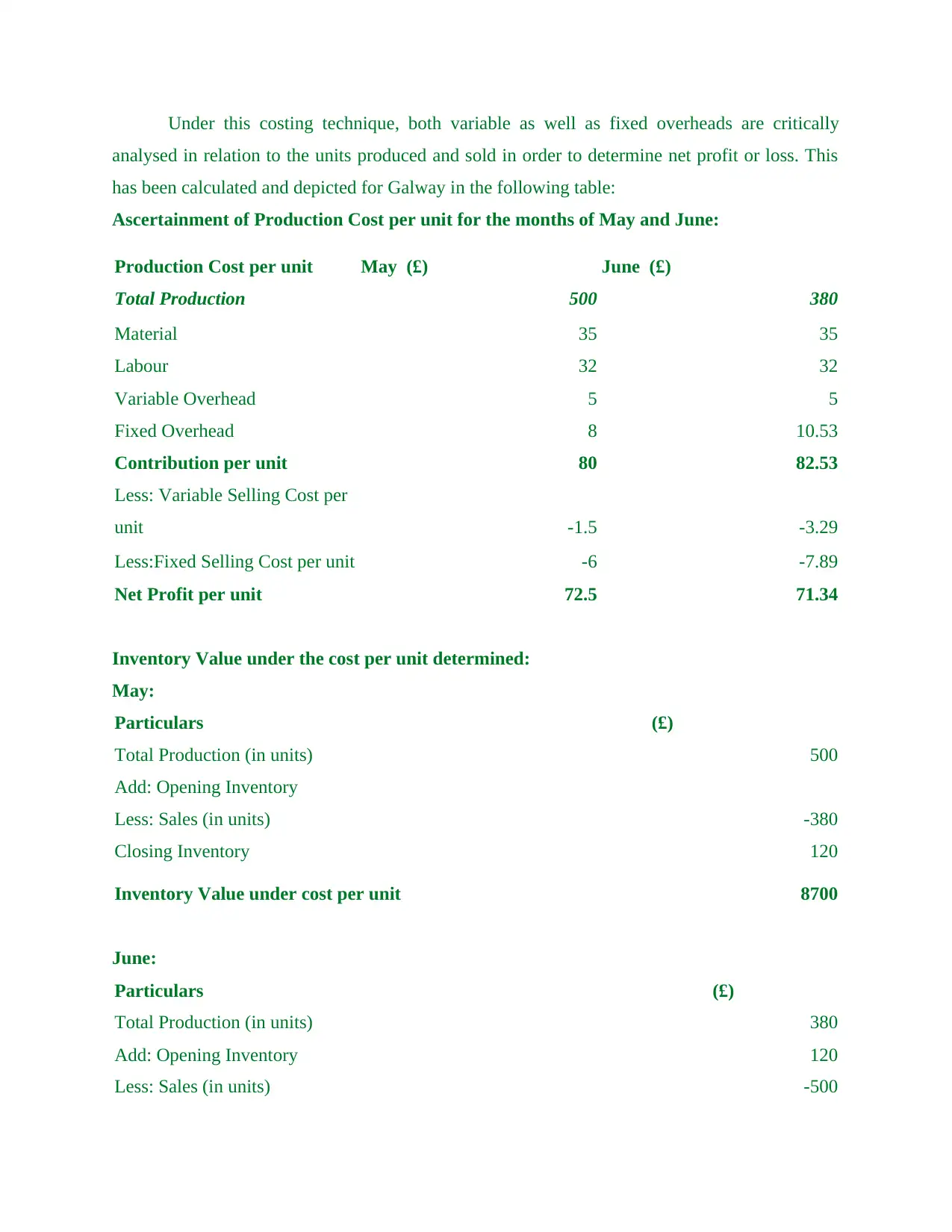
Under this costing technique, both variable as well as fixed overheads are critically
analysed in relation to the units produced and sold in order to determine net profit or loss. This
has been calculated and depicted for Galway in the following table:
Ascertainment of Production Cost per unit for the months of May and June:
Production Cost per unit May (£) June (£)
Total Production 500 380
Material 35 35
Labour 32 32
Variable Overhead 5 5
Fixed Overhead 8 10.53
Contribution per unit 80 82.53
Less: Variable Selling Cost per
unit -1.5 -3.29
Less:Fixed Selling Cost per unit -6 -7.89
Net Profit per unit 72.5 71.34
Inventory Value under the cost per unit determined:
May:
Particulars (£)
Total Production (in units) 500
Add: Opening Inventory
Less: Sales (in units) -380
Closing Inventory 120
Inventory Value under cost per unit 8700
June:
Particulars (£)
Total Production (in units) 380
Add: Opening Inventory 120
Less: Sales (in units) -500
analysed in relation to the units produced and sold in order to determine net profit or loss. This
has been calculated and depicted for Galway in the following table:
Ascertainment of Production Cost per unit for the months of May and June:
Production Cost per unit May (£) June (£)
Total Production 500 380
Material 35 35
Labour 32 32
Variable Overhead 5 5
Fixed Overhead 8 10.53
Contribution per unit 80 82.53
Less: Variable Selling Cost per
unit -1.5 -3.29
Less:Fixed Selling Cost per unit -6 -7.89
Net Profit per unit 72.5 71.34
Inventory Value under the cost per unit determined:
May:
Particulars (£)
Total Production (in units) 500
Add: Opening Inventory
Less: Sales (in units) -380
Closing Inventory 120
Inventory Value under cost per unit 8700
June:
Particulars (£)
Total Production (in units) 380
Add: Opening Inventory 120
Less: Sales (in units) -500
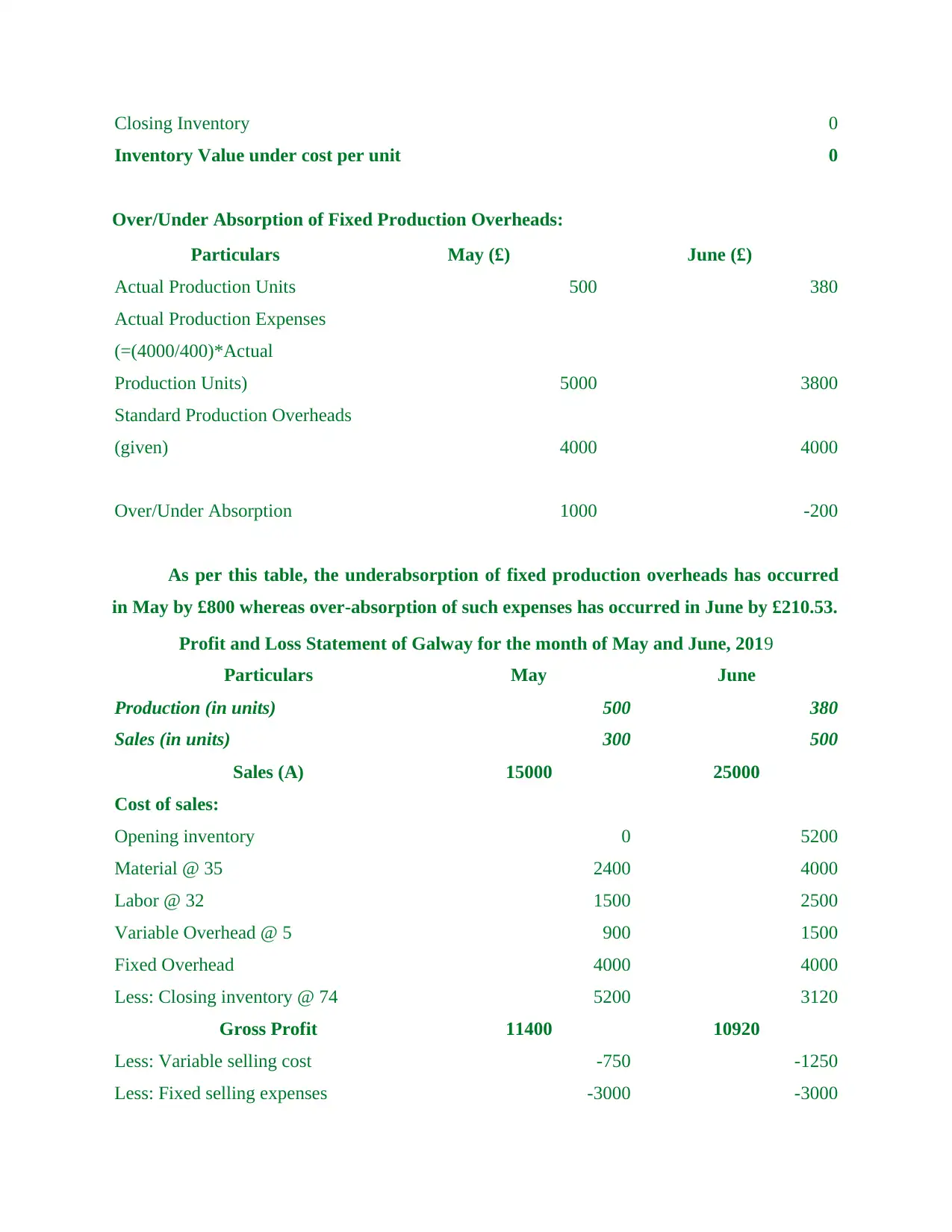
Closing Inventory 0
Inventory Value under cost per unit 0
Over/Under Absorption of Fixed Production Overheads:
Particulars May (£) June (£)
Actual Production Units 500 380
Actual Production Expenses
(=(4000/400)*Actual
Production Units) 5000 3800
Standard Production Overheads
(given) 4000 4000
Over/Under Absorption 1000 -200
As per this table, the underabsorption of fixed production overheads has occurred
in May by £800 whereas over-absorption of such expenses has occurred in June by £210.53.
Profit and Loss Statement of Galway for the month of May and June, 2019
Particulars May June
Production (in units) 500 380
Sales (in units) 300 500
Sales (A) 15000 25000
Cost of sales:
Opening inventory 0 5200
Material @ 35 2400 4000
Labor @ 32 1500 2500
Variable Overhead @ 5 900 1500
Fixed Overhead 4000 4000
Less: Closing inventory @ 74 5200 3120
Gross Profit 11400 10920
Less: Variable selling cost -750 -1250
Less: Fixed selling expenses -3000 -3000
Inventory Value under cost per unit 0
Over/Under Absorption of Fixed Production Overheads:
Particulars May (£) June (£)
Actual Production Units 500 380
Actual Production Expenses
(=(4000/400)*Actual
Production Units) 5000 3800
Standard Production Overheads
(given) 4000 4000
Over/Under Absorption 1000 -200
As per this table, the underabsorption of fixed production overheads has occurred
in May by £800 whereas over-absorption of such expenses has occurred in June by £210.53.
Profit and Loss Statement of Galway for the month of May and June, 2019
Particulars May June
Production (in units) 500 380
Sales (in units) 300 500
Sales (A) 15000 25000
Cost of sales:
Opening inventory 0 5200
Material @ 35 2400 4000
Labor @ 32 1500 2500
Variable Overhead @ 5 900 1500
Fixed Overhead 4000 4000
Less: Closing inventory @ 74 5200 3120
Gross Profit 11400 10920
Less: Variable selling cost -750 -1250
Less: Fixed selling expenses -3000 -3000
⊘ This is a preview!⊘
Do you want full access?
Subscribe today to unlock all pages.

Trusted by 1+ million students worldwide
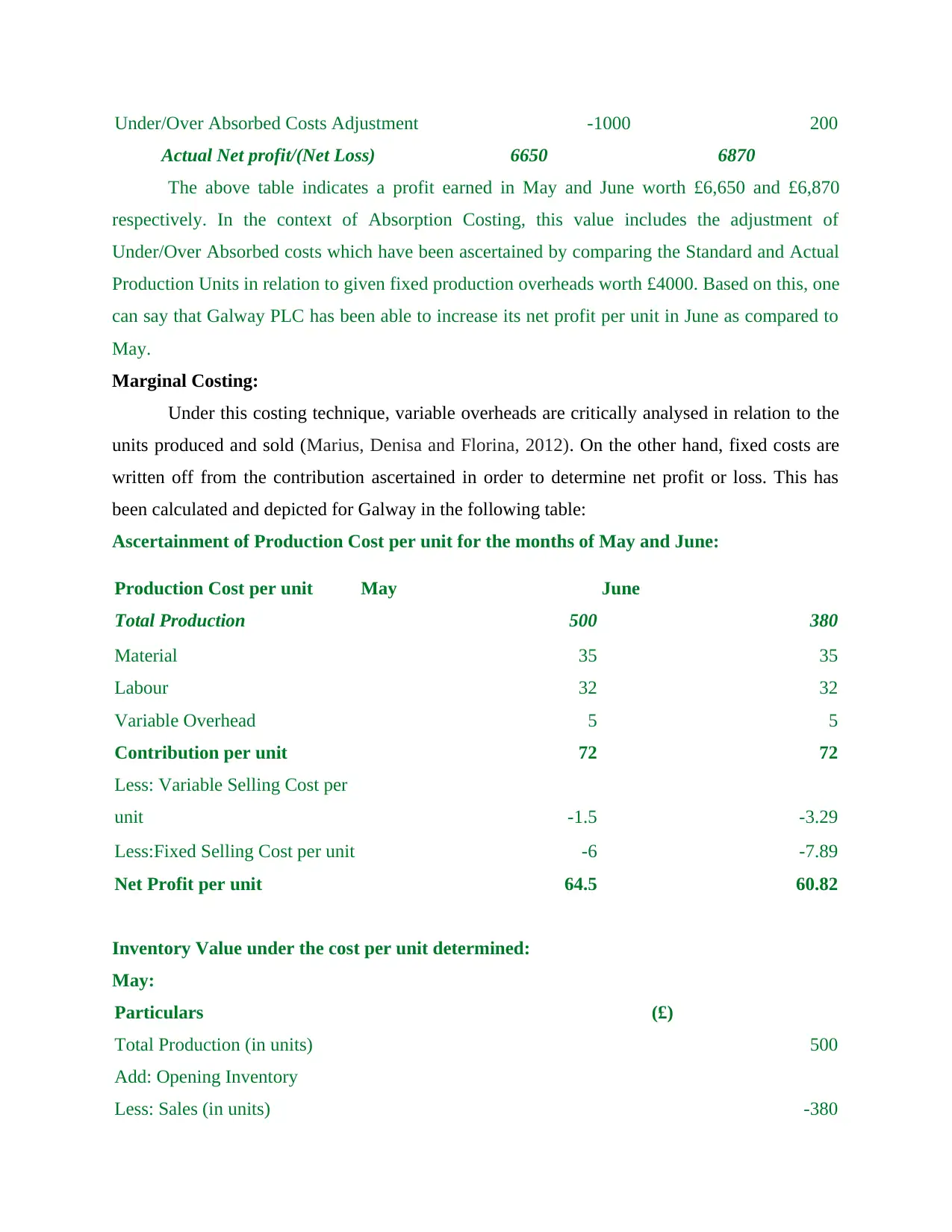
Under/Over Absorbed Costs Adjustment -1000 200
Actual Net profit/(Net Loss) 6650 6870
The above table indicates a profit earned in May and June worth £6,650 and £6,870
respectively. In the context of Absorption Costing, this value includes the adjustment of
Under/Over Absorbed costs which have been ascertained by comparing the Standard and Actual
Production Units in relation to given fixed production overheads worth £4000. Based on this, one
can say that Galway PLC has been able to increase its net profit per unit in June as compared to
May.
Marginal Costing:
Under this costing technique, variable overheads are critically analysed in relation to the
units produced and sold (Marius, Denisa and Florina, 2012). On the other hand, fixed costs are
written off from the contribution ascertained in order to determine net profit or loss. This has
been calculated and depicted for Galway in the following table:
Ascertainment of Production Cost per unit for the months of May and June:
Production Cost per unit May June
Total Production 500 380
Material 35 35
Labour 32 32
Variable Overhead 5 5
Contribution per unit 72 72
Less: Variable Selling Cost per
unit -1.5 -3.29
Less:Fixed Selling Cost per unit -6 -7.89
Net Profit per unit 64.5 60.82
Inventory Value under the cost per unit determined:
May:
Particulars (£)
Total Production (in units) 500
Add: Opening Inventory
Less: Sales (in units) -380
Actual Net profit/(Net Loss) 6650 6870
The above table indicates a profit earned in May and June worth £6,650 and £6,870
respectively. In the context of Absorption Costing, this value includes the adjustment of
Under/Over Absorbed costs which have been ascertained by comparing the Standard and Actual
Production Units in relation to given fixed production overheads worth £4000. Based on this, one
can say that Galway PLC has been able to increase its net profit per unit in June as compared to
May.
Marginal Costing:
Under this costing technique, variable overheads are critically analysed in relation to the
units produced and sold (Marius, Denisa and Florina, 2012). On the other hand, fixed costs are
written off from the contribution ascertained in order to determine net profit or loss. This has
been calculated and depicted for Galway in the following table:
Ascertainment of Production Cost per unit for the months of May and June:
Production Cost per unit May June
Total Production 500 380
Material 35 35
Labour 32 32
Variable Overhead 5 5
Contribution per unit 72 72
Less: Variable Selling Cost per
unit -1.5 -3.29
Less:Fixed Selling Cost per unit -6 -7.89
Net Profit per unit 64.5 60.82
Inventory Value under the cost per unit determined:
May:
Particulars (£)
Total Production (in units) 500
Add: Opening Inventory
Less: Sales (in units) -380
Paraphrase This Document
Need a fresh take? Get an instant paraphrase of this document with our AI Paraphraser
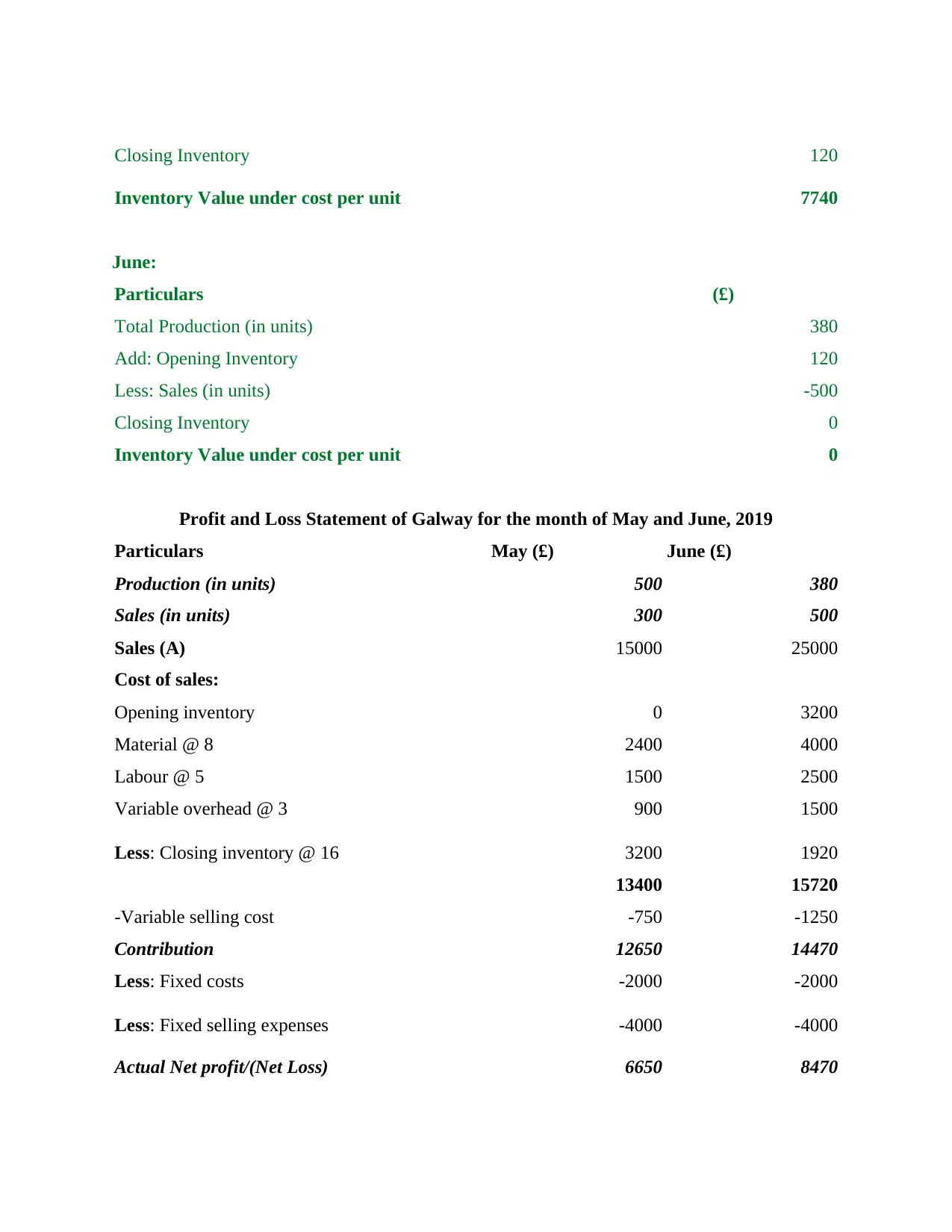
Closing Inventory 120
Inventory Value under cost per unit 7740
June:
Particulars (£)
Total Production (in units) 380
Add: Opening Inventory 120
Less: Sales (in units) -500
Closing Inventory 0
Inventory Value under cost per unit 0
Profit and Loss Statement of Galway for the month of May and June, 2019
Particulars May (£) June (£)
Production (in units) 500 380
Sales (in units) 300 500
Sales (A) 15000 25000
Cost of sales:
Opening inventory 0 3200
Material @ 8 2400 4000
Labour @ 5 1500 2500
Variable overhead @ 3 900 1500
Less: Closing inventory @ 16 3200 1920
13400 15720
-Variable selling cost -750 -1250
Contribution 12650 14470
Less: Fixed costs -2000 -2000
Less: Fixed selling expenses -4000 -4000
Actual Net profit/(Net Loss) 6650 8470
Inventory Value under cost per unit 7740
June:
Particulars (£)
Total Production (in units) 380
Add: Opening Inventory 120
Less: Sales (in units) -500
Closing Inventory 0
Inventory Value under cost per unit 0
Profit and Loss Statement of Galway for the month of May and June, 2019
Particulars May (£) June (£)
Production (in units) 500 380
Sales (in units) 300 500
Sales (A) 15000 25000
Cost of sales:
Opening inventory 0 3200
Material @ 8 2400 4000
Labour @ 5 1500 2500
Variable overhead @ 3 900 1500
Less: Closing inventory @ 16 3200 1920
13400 15720
-Variable selling cost -750 -1250
Contribution 12650 14470
Less: Fixed costs -2000 -2000
Less: Fixed selling expenses -4000 -4000
Actual Net profit/(Net Loss) 6650 8470
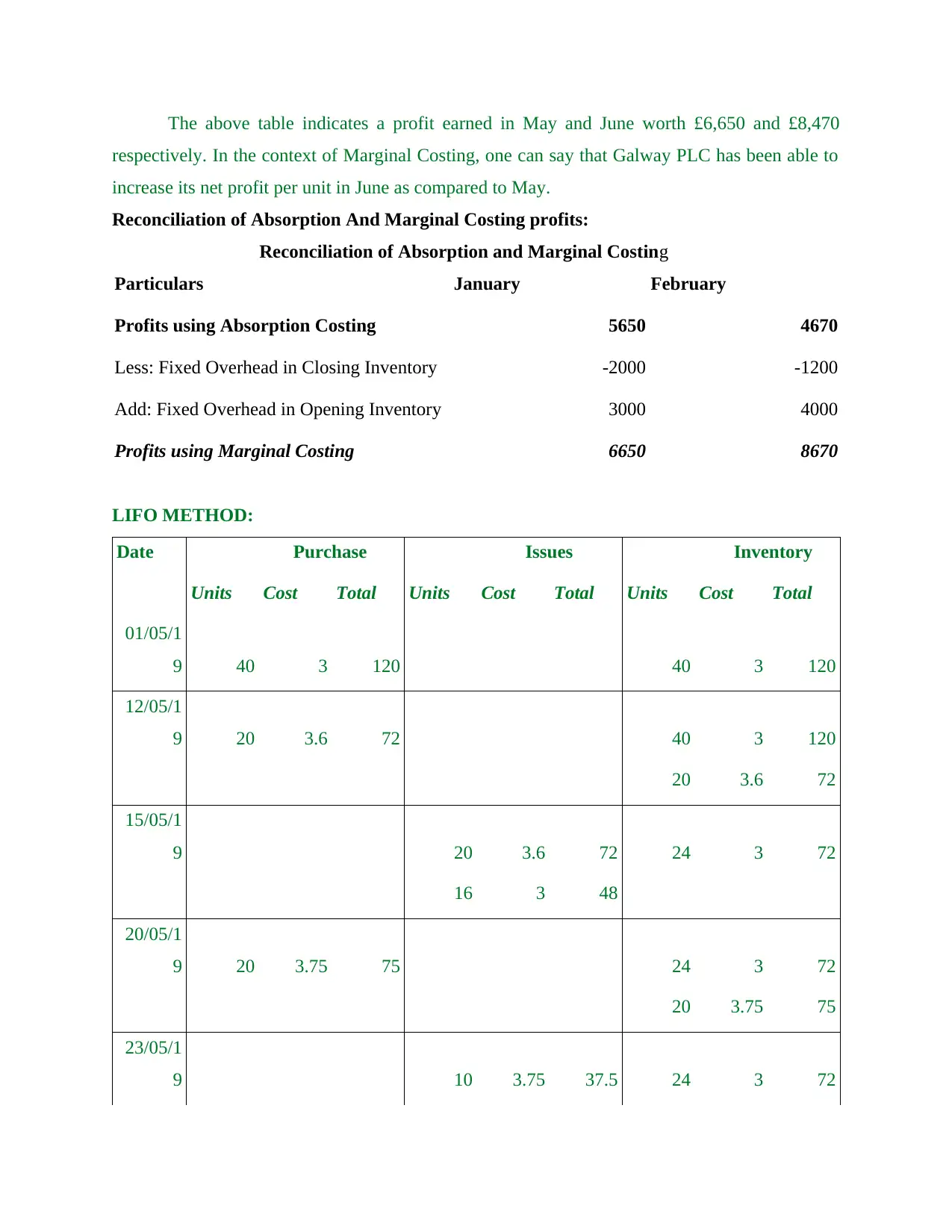
The above table indicates a profit earned in May and June worth £6,650 and £8,470
respectively. In the context of Marginal Costing, one can say that Galway PLC has been able to
increase its net profit per unit in June as compared to May.
Reconciliation of Absorption And Marginal Costing profits:
Reconciliation of Absorption and Marginal Costing
Particulars January February
Profits using Absorption Costing 5650 4670
Less: Fixed Overhead in Closing Inventory -2000 -1200
Add: Fixed Overhead in Opening Inventory 3000 4000
Profits using Marginal Costing 6650 8670
LIFO METHOD:
Date Purchase Issues Inventory
Units Cost Total Units Cost Total Units Cost Total
01/05/1
9 40 3 120 40 3 120
12/05/1
9 20 3.6 72 40 3 120
20 3.6 72
15/05/1
9 20 3.6 72 24 3 72
16 3 48
20/05/1
9 20 3.75 75 24 3 72
20 3.75 75
23/05/1
9 10 3.75 37.5 24 3 72
respectively. In the context of Marginal Costing, one can say that Galway PLC has been able to
increase its net profit per unit in June as compared to May.
Reconciliation of Absorption And Marginal Costing profits:
Reconciliation of Absorption and Marginal Costing
Particulars January February
Profits using Absorption Costing 5650 4670
Less: Fixed Overhead in Closing Inventory -2000 -1200
Add: Fixed Overhead in Opening Inventory 3000 4000
Profits using Marginal Costing 6650 8670
LIFO METHOD:
Date Purchase Issues Inventory
Units Cost Total Units Cost Total Units Cost Total
01/05/1
9 40 3 120 40 3 120
12/05/1
9 20 3.6 72 40 3 120
20 3.6 72
15/05/1
9 20 3.6 72 24 3 72
16 3 48
20/05/1
9 20 3.75 75 24 3 72
20 3.75 75
23/05/1
9 10 3.75 37.5 24 3 72
⊘ This is a preview!⊘
Do you want full access?
Subscribe today to unlock all pages.

Trusted by 1+ million students worldwide
1 out of 20
Related Documents
Your All-in-One AI-Powered Toolkit for Academic Success.
+13062052269
info@desklib.com
Available 24*7 on WhatsApp / Email
![[object Object]](/_next/static/media/star-bottom.7253800d.svg)
Unlock your academic potential
Copyright © 2020–2025 A2Z Services. All Rights Reserved. Developed and managed by ZUCOL.





